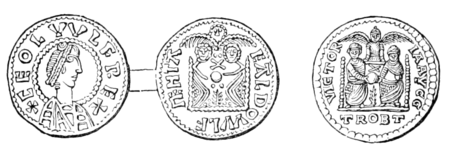the Roman coins, then the chief currency of the country. Without comparing this with the prototype, it would he impossible to conjecture what the artist had intended to represent, but by referring to the common gold coins of Valentinian, it will be seen that the grotesque objects upon the reverse of the Saxon coin are derived from the seated imperial figures on the Roman 'aureus,' behind which stands a Victory with expanded wings. This practice of imitation is strikingly exemplified by the accompanying cuts kindly furnished by the Council of the Numismatic Society. The joined cuts represent the obverse and reverse of a coin of Civlwlf, King of Mercia, A.D. 874; the other is the reverse of a gold coin of Valentinian. Mr. Hawkins, who has published this coin in his paper on the "Coins and Treasure found in Cuerdale," observes: "The diadem and dress of the king is, like that of many other Saxon kings, copied from those of the later Roman emperors: but a reverse upon an indisputably genuine coin, so clearly copied from a Roman type, has not before appeared[1]." The inscription on the reverse of the penny of Civlwlf is ealdovvlf. menta. for Ealdwlf Monetarius.
A letter was read from Archdeacon King, acknowledging the receipt of a letter from the Secretary, and a copy of the "resolution" passed at Canterbury, relative to the paintings in East Wickham church, and stating that he had, immediately upon the receipt of the letter, requested information upon the matter from the minister and churchwardens.
A letter was read from Messrs. Hodges and Smith, of Dublin, to Lord Albert Conyngham, on an account attached to the genealogy of the Waller family, under the name of "Richard Waller" upon a roll dated 1625, which refers to the building of Groombridge House in the county of Kent, for Richard Waller, by the Duke of Orleans, taken prisoner by him at the battle of Agincourt.
Upon the suggestion of the Rev. J. B. Deane, it was resolved, that the Committee authorize their secretary, Mr. Smith, to visit, inspect, and report upon some remains on the site of a supposed Roman villa on Lanham Down, near Alresford, Hants, with a view to enable the Hon. Col. Mainwaring Ellenker Onslow to form an opinion respecting the probable success of an excavation on an extended scale about to be undertaken, if advised, by that gentleman.
Mr. Wright read a communication from the Rev. Lambert B. Larking, who stated that "a few weeks since some labourers, in digging for gravel on the hill above the manor-house of Leckhampton, about two miles from Cheltenham, suddenly came upon a skeleton, in a bank at the side of the high-road leading from Cheltenham to Bath. It was lying doubled up about 3 feet under the surface; it was quite perfect, not even a tooth wanting. On the skull, fitting
- ↑ Numismatic Clnonicle, vol. v. p. 10.

